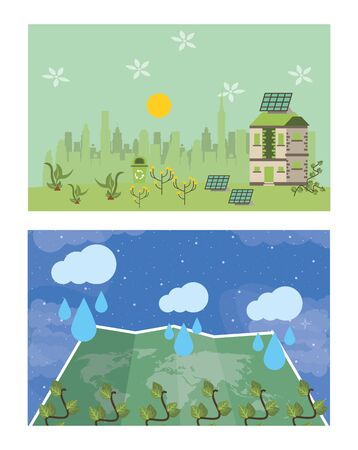Understanding Eco-Friendly Materials
When shopping for a sustainable tent, the first thing to look at is what its made of. Eco-friendly tents use materials that are better for the environment, both during production and after youre done using them. These materials help reduce waste, lower emissions, and often last longer too—making them a smart choice for both nature lovers and practical campers.
Common Sustainable Fabrics
Many traditional tents are made with synthetic fabrics treated with chemicals that arent great for the planet. Luckily, newer eco-conscious options offer better alternatives:
| Material | Description | Eco Benefits |
|---|---|---|
| Recycled Polyester (rPET) | Made from recycled plastic bottles | Reduces landfill waste and energy use compared to virgin polyester |
| Organic Cotton | Grown without harmful pesticides or synthetic fertilizers | Biodegradable and safer for soil and water systems |
Sustainable Coatings and Dyes
A tents water resistance often comes from chemical coatings, but not all coatings are created equal. Look for options that avoid toxic substances like PVC or PFCs (perfluorocarbons), which can harm wildlife and pollute waterways.
Eco-Dyes
Eco-dyes are used to color fabrics without harsh chemicals. These dyes are usually plant-based or low-impact synthetic dyes that require less water and energy during processing. Choosing tents dyed with eco-dyes supports cleaner production methods.
Environmentally Responsible Frame Materials
The frame of your tent matters too. Traditional metal poles can be heavy and energy-intensive to produce. Many eco-friendly tents use alternative materials:
| Frame Material | Description | Eco Benefits |
|---|---|---|
| Bamboo | A fast-growing, renewable resource used in some lightweight poles | Sustainable harvesting and biodegradable over time |
| Recycled Aluminum | Aluminum that’s been reused instead of newly mined | Cuts down on mining impact and saves energy during production |
Quick Tip:
Check if the manufacturer is transparent about their material sourcing. Brands committed to sustainability often share details about where their materials come from and how they’re processed.
2. Sustainability Certifications and Standards
When shopping for an eco-friendly tent, its not just about the materials—its also important to consider how the tent was made. That’s where sustainability certifications come in. These labels help you identify products that are produced with care for both people and the planet. Here are some key certifications to look for when choosing a sustainable tent:
bluesign®
The bluesign® system focuses on responsible and sustainable manufacturing of textile products. It ensures that harmful substances are eliminated from the beginning of the manufacturing process and sets strict standards for environmentally friendly and safe production.
Why It Matters:
- Reduces water, air, and soil pollution
- Protects workers’ health during production
- Ensures safer products for end users
Global Recycled Standard (GRS)
The GRS certifies products made with recycled materials. It tracks the recycled content throughout the supply chain and includes strict social and environmental requirements.
Why It Matters:
- Verifies the use of genuine recycled materials
- Encourages responsible use of resources
- Improves traceability in the supply chain
Fair Trade Certified™
This certification ensures that workers involved in making your tent are treated fairly, work in safe conditions, and receive fair wages. Fair Trade also promotes environmental responsibility.
Why It Matters:
- Supports better working conditions
- Empowers communities through fair wages
- Promotes environmentally conscious practices
Certification Comparison Table
| Certification | Main Focus | Environmental Impact | Social Impact |
|---|---|---|---|
| bluesign® | Sustainable chemical management and safety in textile production | High – Reduces pollutants and waste | Medium – Safer conditions for factory workers |
| GRS (Global Recycled Standard) | Recycled content verification and supply chain tracking | High – Promotes recycling and resource efficiency | Medium – Includes social criteria for facilities |
| Fair Trade Certified™ | Fair labor practices and community support | Medium – Encourages sustainable farming and production methods | High – Ensures fair treatment of workers and producers |
Selecting a tent with one or more of these certifications can make a big difference. Not only are you supporting brands that care about sustainability, but youre also investing in a product that’s better for the environment—and for the people who make it.

3. Durability and Longevity: Buy Less, Waste Less
When shopping for an eco-friendly tent, durability should be at the top of your list. A tent that’s built to last not only saves you money over time but also helps reduce your environmental impact. The longer a tent lasts, the fewer tents you’ll need to buy—and that means less waste ending up in landfills.
Why Durability Matters
Most cheap tents are made with lower-quality materials and stitching that wear out after just a few trips. These tents often tear easily, lose waterproofing quickly, or have poles that snap under pressure. In contrast, durable tents are made from high-quality fabrics, strong zippers, and sturdy frames designed to withstand years of use in various weather conditions.
Benefits of a Durable Tent
| Feature | Environmental Benefit | Personal Benefit |
|---|---|---|
| Long-lasting materials | Fewer replacements = less production waste | Saves money over time |
| Repairable components | Reduces landfill waste | You can fix instead of replace |
| All-weather design | Less chance of emergency replacements due to damage | Peace of mind on any trip |
What to Look For in a Long-Lasting Tent
- High-denier fabric: Look for ripstop nylon or polyester with higher denier ratings—these resist tearing and UV damage better.
- Taped seams and reinforced stitching: These features prevent leaks and extend the life of your tents structure.
- Strong poles: Aluminum poles are more durable and eco-friendly than fiberglass alternatives.
- Zipper quality: YKK zippers are known for their strength and reliability.
Pro Tip:
If a tent comes with a repair kit or offers replacement parts, that’s a good sign it’s made to be used for years—not just one season.
A well-built tent may cost more upfront, but its durability makes it a smarter investment for both your wallet and the planet. By choosing long-lasting gear, youre helping reduce unnecessary waste and promoting sustainable outdoor living.
4. Repairability and End-of-Life Options
When youre investing in an eco-friendly tent, its not just about how its made—its also about how long it lasts and what happens when it reaches the end of its life. Choosing a tent thats easy to repair and recycle helps reduce waste and saves you money in the long run.
Why Repairability Matters
Tents take a beating out in nature. Zippers break, poles snap, and fabric tears. But if your tent is designed with repairability in mind, these issues don’t mean the end of your gear. Look for brands that offer:
- Modular parts: Poles, stakes, and zippers that can be replaced individually
- Repair kits included: Some tents come with patches or pole splints so you can fix things on-site
- Accessible support: Brands that provide online guides or customer service for DIY fixes
Sustainable End-of-Life Solutions
No gear lasts forever, but responsible brands are changing how we dispose of old tents. Some now offer options that keep your gear out of the landfill. Here are a few innovations to look out for:
| Brand Initiative | Description |
|---|---|
| Take-Back Programs | You return your old tent to the company, and they reuse or recycle the materials properly. |
| Biodegradable Components | Certain tent parts, like stakes or fabric coatings, are made from materials that break down naturally over time. |
| Upcycling Partnerships | Some companies partner with artists or organizations to turn old tents into bags, tarps, or other useful items. |
Tips for Choosing a More Repairable Tent
- Check product specs: Look for info about replaceable parts and included repair kits.
- Read reviews: See what other campers say about ease of maintenance.
- Ask questions: Don’t hesitate to contact the brand before buying to ask about their repair or recycling policies.
The Bigger Picture
Tents designed with repairability and responsible disposal in mind help reduce environmental impact while also being more budget-friendly over time. By supporting brands that prioritize these features, youre casting a vote for a more sustainable outdoor industry—and making sure your adventures leave less of a mark on the wild places you love.
5. Choosing the Right Size and Style for Low-Impact Camping
When it comes to eco-friendly camping, picking the right tent size and style isn’t just about comfort—it also plays a big role in minimizing your impact on the environment. A well-chosen tent helps reduce campsite disturbance, supports Leave No Trace principles, and makes your outdoor adventure more sustainable.
Why Tent Size Matters
Bigger isn’t always better when camping with nature in mind. Oversized tents can damage vegetation, take up unnecessary space, and even require larger cleared areas to set up. Choose a tent that fits your group size without going overboard. Here’s a quick guide:
| Group Size | Recommended Tent Size | Eco-Friendly Tip |
|---|---|---|
| Solo Camper | 1-2 person tent | Lightweight, minimal footprint |
| Couple or Duo | 2-3 person tent | Roomy yet compact enough for small campsites |
| Family (3-4 people) | 4-person tent | Avoid oversized models; go for vertical space efficiency |
| Larger Group (5+) | Multiple smaller tents | Split into smaller groups to reduce site disruption |
Selecting a Low-Impact Tent Style
The design and structure of your tent can affect how much you disturb the land. Here are some eco-conscious styles to consider:
- Dome Tents: Compact footprint and stable in various weather conditions.
- Tunnel Tents: Great for families, but make sure they fit within designated camping areas.
- Backpacking Tents: Lightweight and perfect for minimal-impact travel.
- Tarp Shelters: Offer flexibility and require fewer materials, ideal for ultralight campers.
Additional Tips for Eco-Friendly Tent Selection:
- Avoid tents with large vestibules or extended footprints: These take up more space than necessary.
- Use freestanding tents when possible: They require less anchoring and leave fewer marks on the ground.
- Choose neutral-colored tents: Earth-tone colors blend into natural settings better and minimize visual disruption.
- Opt for tents made from recycled or sustainably sourced materials: These support environmentally responsible manufacturing practices.
Final Tip: Practice Leave No Trace Camping with Your Tent Choice
Your tent is your home away from home—but it shouldnt leave a mark. By choosing a right-sized, low-impact style that suits your camping lifestyle, you help preserve nature for others to enjoy. Every small decision counts toward making outdoor spaces cleaner and greener.
6. Top Eco-Friendly Tent Brands in the U.S.
When it comes to buying an eco-friendly tent, choosing a trusted brand makes a big difference. Some American companies are going the extra mile by designing sustainable tents, using responsible manufacturing practices, and giving back to their communities. Below, we highlight some of the top eco-conscious tent brands that are leading the way in the U.S.
Why Brand Matters
Not all tents are created equal. Eco-friendly brands focus on reducing their environmental footprint from start to finish. This includes using recycled or organic materials, minimizing waste during production, and ensuring fair labor practices. Supporting these companies means youre also supporting a healthier planet.
Leading Sustainable Tent Brands
| Brand | Eco Features | Community Involvement |
|---|---|---|
| NEMO Equipment | Uses bluesign®-approved fabrics, designs for longevity, and offers a repair program. | Partners with environmental nonprofits and supports diversity in the outdoors. |
| The North Face | Incorporates recycled materials and runs the “Clothes the Loop” recycling program. | Invests in outdoor education and climate advocacy programs. |
| Big Agnes | Committed to carbon offsetting, uses solution-dyed fabrics to save water and energy. | Supports local trail maintenance and public lands conservation projects. |
| Sierra Designs | Focuses on minimalist design to reduce waste, uses PFC-free coatings. | Partners with organizations promoting outdoor access for all. |
What Sets These Brands Apart?
These companies dont just make gear—they make a difference. From transparent supply chains to giving back through charitable programs, they go beyond selling products. They help protect the wild places we love to camp in while inspiring more people to enjoy them responsibly.
Quick Tips When Choosing a Brand
- Look for certifications like bluesign®, Fair Trade Certified™, or Climate Neutral Certified.
- Check if the brand offers repair services—this helps reduce waste long-term.
- Read up on each companys sustainability reports or environmental initiatives online.
Your Choice Matters
By choosing tents from these forward-thinking American brands, youre not only investing in quality gear but also supporting a movement toward greener outdoor adventures. Every purchase is a vote for the kind of future you want to see—one where camping stays wild, clean, and accessible for generations to come.


